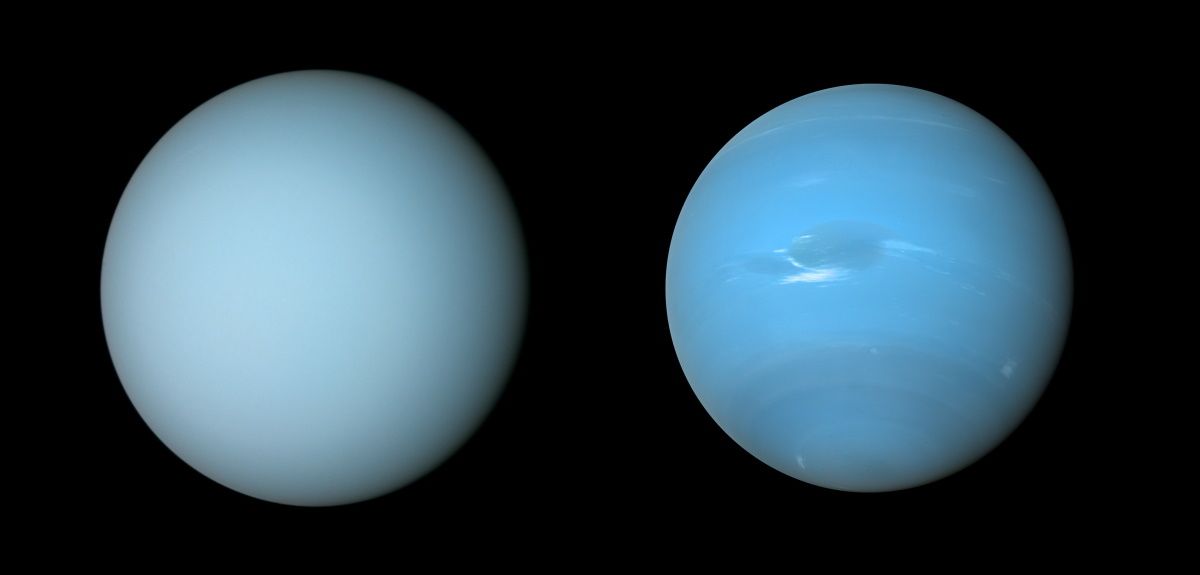
Credit: NASA/JPL-Caltech/B. Jónsson
Scientists explain why Uranus and Neptune are different colours
Layers of haze particles are responsible for the different blue hues of the ice giants Neptune and Uranus.
Neptune and Uranus have much in common – they have similar masses, sizes, and atmospheric compositions – yet Neptune looks distinctly bluer than its planetary neighbour Uranus.
New research led by Professor Patrick Irwin, Department of Physics, University of Oxford suggests that a layer of haze that exists on both planets is behind the different hues of blue. If there were no haze in the atmospheres of Neptune and Uranus, both would appear almost equally blue.
Using observations from the Hubble Space Telescope, the NASA Infrared Telescope Facility, and the Gemini North telescope, an international team of researchers developed a model to describe aerosol layers in the atmospheres of Neptune and Uranus.
‘This is the first model to simultaneously fit observations of reflected sunlight from ultraviolet to near-infrared wavelengths,’ explained Professor Irwin, lead author of the paper published in Journal of Geophysical Research: Planets. ‘It’s also the first to explain the difference in visible colour between Uranus and Neptune.’
The team’s model involves three haze layers at different heights in the atmospheres of each planet. The middle layer of haze particles, just above the methane condensation level, is found to be thicker on Uranus than on Neptune, which affects the visible colour of the two planets.
On both planets, methane ice condenses on the particles in the middle layer forming a shower of methane snow that pulls the haze particles deeper into the atmosphere, where they can then promote the condensation of hydrogen sulphide ice, forming a separate, deeper layer of cloud/haze.
Neptune has a more active, turbulent atmosphere than Uranus, suggesting Neptune’s atmosphere is more efficient at churning up gaseous methane into the haze layer where it can condense on the haze particles and produce this snow. This action removes more of the haze and keeps Neptune’s haze layer thinner than it is on Uranus, making Neptune appear bluer than Uranus.
In contrast, excess haze on Uranus builds up in the planet’s stagnant, sluggish atmosphere giving it a lighter tone than Neptune.
The team’s research also showed the presence of a second, deeper layer in the model that, when darkened, could account for dark spots occasionally visible on Neptune and more sporadically on Uranus, such as the famous Great Dark Spot (GDS-89) on Neptune observed by Voyager 2 in 1989.
While astronomers were already aware of the presence of dark spots in the atmospheres of both planets, they didn’t know which haze layer was causing these dark spots or whether they were caused by a thinning or darkening of this layer.
‘We hoped that developing this model would help us understand clouds and hazes in the ice giant atmospheres,’ said Dr Mike Wong, an astronomer at the University of California, Berkeley, and a member of the team behind this result. ‘Explaining the difference in colour between Uranus and Neptune was an unexpected bonus!’
The full paper, ‘Hazy blue worlds: A holistic aerosol model for Uranus and Neptune, including Dark Spots,’ is available in the Journal of Geophysical Research: Planets.
 New analysis of archaeological data reveals how agriculture and governance have shaped wealth inequality
New analysis of archaeological data reveals how agriculture and governance have shaped wealth inequality
 Cambridge victorious in Women's and Men's Boat Races 2025
Cambridge victorious in Women's and Men's Boat Races 2025
 Expert Comment: Ethical and legal challenges of uterus transplants in Mexico
Expert Comment: Ethical and legal challenges of uterus transplants in Mexico